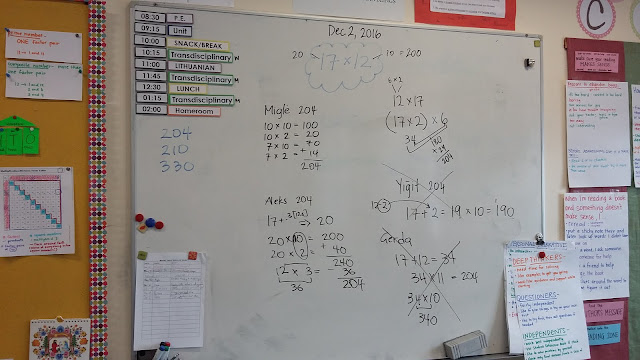This week in Unit, we began to investigate and explore line of inquiry 3: There is historical evidence of enduring species.
We began by exploring the idea of evolution. I drew a little creature which all the students copied. From the variations of creatures, we chose our favorite one collectively. All the other pictures were removed and we discussed how the swamp dried up and all the ones that were removed had sadly died.
 |
| Elena and Shourya copy Generation 0 |
 |
| Yigit's interpretation of Generation 0 |
 |
| Generation 1 top left and all of his 'relatives'. Students chose which one of these mutations would best survive the desert habitat change |
 |
| Steven and Benas copy Generation 1 |
Again we posted all of our work and this time we selected the one that we thought was best adapted to survive in the desert. Different students volunteered to justify why certain versions of our creature would thrive or die until we were down to just one again- we called this 'Generation 2'.
 |
| Nora explains why this particular species would or would not survive in a desert climate |
 |
| Shourya shares his thinking about another relative |
 |
| Migle shares her Generation 5 |
 |
| Veronika works on her Generation 5 creation |
 |
| Generation 0-5 |
We followed this activity with a discussion of what the students thought evolution meant. There were many interesting thoughts on what had just happened to our little creature!
We then broke into pairs to analyse the changes we had seen our creature go through by annotating one graphic of the process. During a whole group discussion, students theorised about what might have created such changes/mutations and how those mutations might have promoted survival over time.
Our understanding began to change as our discussions grew more complex, so we dug a little deeper. We looked back at the central idea: Over time living things must change in order to survive, and tried to connect it to our thinking.
In groups of 3, we watched videos on:
We answered a few questions and then summarised our big understanding using the 'Headlines' routine from Making Thinking Visible. Again we engaged in thoughtful discussion around our big ideas, and continued to build understanding toward our central idea.
Our transdisciplinary work for Unit 2 continued as we saw our imaginary creatures come to 'life' in the form of clay in drama.
We worked during writing to create simple storyboards we could use to tell the story of an animal entering our habitat or of joining a new habitat. We then took the habitats we created in art up to drama on Wednesday, and began taking photos for our stop-motion animation films.
We watched videos of ourselves acting this scenario out in drama, and then set to writing out the full story as diary entries from our creature's perspective.
In math, we continued to work with multiplication. We are growing more confident during multiplication number talks. Several students have begun taking risks as they experiment with new strategies for mental problem solving. Not all of the strategies are successful, but the act of inquiring and proving/disproving these strategies demonstrates that deeper thinking we value in 4L. We have added one new multiplication strategy to our chart this week.
 |
| Here you see that Gerda and Yigit both tried out new strategies but when we worked collaboratively, we could not yet prove they work |
 |
| Nora and Elena, Aleksandras and Rojus play games to practice multiplication and division |
On Friday, we continued work with our Passion Projects. We were delighted to see the progress our classmates had made on their various learning journeys. From sewing dog clothes and stuffed animals, to walking robot frogs, to collaborative efforts on new songs... it was a great place to be Friday afternoon!
At the end of every Genius Hour, the students communicate their next steps and what we should see by next Friday. It is such an inspiration and pleasure to see how the students encourage and support one another in their efforts to reach their goals.


No comments:
Post a Comment